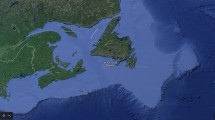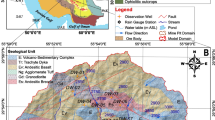Most underground gas storage in China encounters the problem of evaluating gas drainage. In order to evaluate the gas reservoir parameters, we propose a mathematical model for calculating the gas drainage radius. The model describes the gas seepage mechanism based on material balance, and lets us evaluate the gas drainage radius for any well pattern and also to calculate the optimal production parameters in a limited production time range. Experimental results have demonstrated the accuracy of the model. We have conducted studies to assess the nature of the dependence on the drainage radius on various reservoir parameters. The results have shown that the radius depends on multiple variables. For example, the radius increases as production time and the rock permeability increase. The field tests conducted have shown that the radius values calculated based on the mathematical model quite accurately match the actual parameters for existing underground gas storage at the Dagang field.


Similar content being viewed by others
References
Ligen Tang, Jieming Wang, Guosheng Ding et al. “Forecast inflow-performance of wells in gas storage based on data from field exploration & development,” Petroleum Exploration and Development, 43, No. 1, 1-4 (2016).
Ligen Tang, Jieming Wang, Fengjuan Bai et al., “Inventory forecast in underground gas storage based on modified material balance equation,” Petroleum Exploration and Development, 41, No. 4, 480-484 (2014).
Guosheng Ding, Chun Li, Jieming Wang et al., “The status and technical development direction of underground gas storages in China,” Natural Gas Industry, 35, No. 11, 107-112 (2015).
Rai Zhang, Yuxue Chen, Liming Zhang et al., “Well pattern optimization using NEWUOA algorithm,” Journal of Petroleum Science and Engineering, 134, 257-272 (2015).
Jing-Chun Feng, Yi Wang, Xiao-Sen Li et al., “Effect of horizontal and vertical well patterns on methane hydrate dissociation behaviors in pilot-scale hydrate simulator,” Applied Energy, 145, 69-79 (2015).
Dongbo He, Alba Jia, Guang Ji et al., “Well type and pattern optimization technology for large scale tight sand gas, Sulige gas field, NW China,” Petroleum Exploration and Development, 40, No. 1, 84-95 (2013).
Quanyou Liu, Zhijun lin, Qingqiang Meng et al., “Genetic types of natural gas and filling patterns in Daniudi gas field, Ordos Basin, China,” Journal of Asian Earth Sciences, 107, 1-11 (2015).
Jeremy Rohmera and Jean-Charles Mane eau, “Tracing back the pressure-impact zone of the CO, geological storage through a cyclic injection strategy,” Energy Procedia, 37, 4234-4241 (2013).
Laurent Beccaletto, Franck Hanot, Olivier Serrano et al., “Overview of the subsurface structural pattern of the Paris Basin (France): Insights from the reprocessing and interpretation of regional seismic lines,” Marine and Petroleum Geology, 28, No. 4,861-879 (2011).
R. G. Agarwal, D. C. Gardner, S. W. Kleinsteiber et al., :Analyzing well production data using combined-type-curve and decline-curve analysis concepts,” SPE57916 (1999).
Zhiming Fang and Xiaochun Li, “Preliminary assessment of CO2 geological storage potential in Chongqing, China,” Procedia Environmental Sciences, Part C, 11, 1064-1071 (2011).
Yong Hu, Xizhe Li, Xiangguo Lu et al., “Varying law of water saturation in the depletion-drive development of sandstone gas reservoirs,” Petroleum Exploration and Development, 41, No. 6, 723-726 (2014).
Xueliang He, Sheijun Huang, Changwei Sun et al., “Gas-water relative permeability variation in multi-cycle injection production of underground gas storage in flooded depleted gas reservoir,” Oil & Gas Storage and Transportation, 34, No. 2, 150-153 (2015).
Zaitong Liu and Jianwei Wang, “Large hole drilling technology for underground salt-cavern gas storage in Turkey,” Oil Drilling & Production Technology, 37, No. 2, 32-34 (2015).
L. P. Dake. Fundamentals of Reservoir Engineering, Elsevier (1998), pp. 127-148.
Shujie Jing and Yingying Xue, “A class of new structural quasi-Newton algorithm under Wolfe line search,” Journal of Henan Polytechnic University (Natural Science), 34, No. 4, 549-592 (2015).
Ligen Tang, Jieming Wang, and Fengjuan Bai, “Application of NPI decline to gas-injection transient analysis,” IGRC (2014).
Author information
Authors and Affiliations
Additional information
Translated from Khimiya i Tekhnologiya Topliv i Masel, No. 4, pp. 67 – 71, July – August, 2018.
Rights and permissions
About this article
Cite this article
Ligen, T., Guosheng, D., Chunhui, S. et al. Mathematical Description of Gas Drainage Radius for Underground Gas Storage. Chem Technol Fuels Oils 54, 500–508 (2018). https://doi.org/10.1007/s10553-018-0952-5
Published:
Issue Date:
DOI: https://doi.org/10.1007/s10553-018-0952-5




